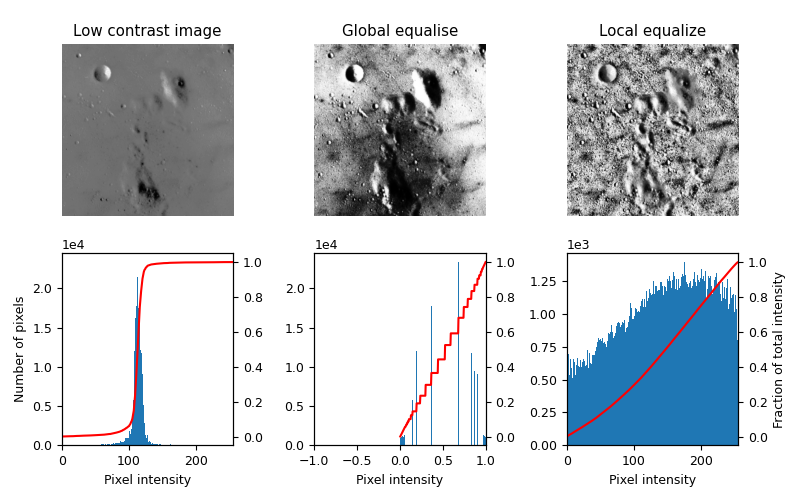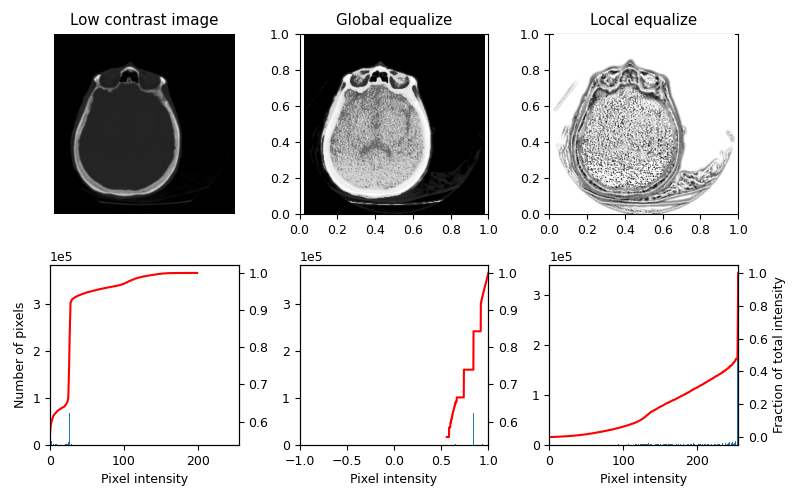Note
Go to the end to download the full example code or to run this example in your browser via Binder.
Local Histogram Equalization#
This example enhances an image with low contrast, using a method called local histogram equalization, which spreads out the most frequent intensity values in an image.
The equalized image [1] has a roughly linear cumulative distribution function for each pixel neighborhood.
The local version [2] of the histogram equalization emphasized every local graylevel variations.
These algorithms can be used on both 2D and 3D images.
References#
import numpy as np
import matplotlib
import matplotlib.pyplot as plt
from skimage import data
from skimage.util.dtype import dtype_range
from skimage.util import img_as_ubyte
from skimage import exposure
from skimage.morphology import disk
from skimage.morphology import ball
from skimage.filters import rank
matplotlib.rcParams['font.size'] = 9
def plot_img_and_hist(image, axes, bins=256):
"""Plot an image along with its histogram and cumulative histogram."""
ax_img, ax_hist = axes
ax_cdf = ax_hist.twinx()
# Display image
ax_img.imshow(image, cmap=plt.cm.gray)
ax_img.set_axis_off()
# Display histogram
ax_hist.hist(image.ravel(), bins=bins)
ax_hist.ticklabel_format(axis='y', style='scientific', scilimits=(0, 0))
ax_hist.set_xlabel('Pixel intensity')
xmin, xmax = dtype_range[image.dtype.type]
ax_hist.set_xlim(xmin, xmax)
# Display cumulative distribution
img_cdf, bins = exposure.cumulative_distribution(image, bins)
ax_cdf.plot(bins, img_cdf, 'r')
return ax_img, ax_hist, ax_cdf
# Load an example image
img = img_as_ubyte(data.moon())
# Global equalize
img_rescale = exposure.equalize_hist(img)
# Equalization
footprint = disk(30)
img_eq = rank.equalize(img, footprint=footprint)
# Display results
fig = plt.figure(figsize=(8, 5))
axes = np.zeros((2, 3), dtype=object)
axes[0, 0] = plt.subplot(2, 3, 1)
axes[0, 1] = plt.subplot(2, 3, 2, sharex=axes[0, 0], sharey=axes[0, 0])
axes[0, 2] = plt.subplot(2, 3, 3, sharex=axes[0, 0], sharey=axes[0, 0])
axes[1, 0] = plt.subplot(2, 3, 4)
axes[1, 1] = plt.subplot(2, 3, 5)
axes[1, 2] = plt.subplot(2, 3, 6)
ax_img, ax_hist, ax_cdf = plot_img_and_hist(img, axes[:, 0])
ax_img.set_title('Low contrast image')
ax_hist.set_ylabel('Number of pixels')
ax_img, ax_hist, ax_cdf = plot_img_and_hist(img_rescale, axes[:, 1])
ax_img.set_title('Global equalise')
ax_img, ax_hist, ax_cdf = plot_img_and_hist(img_eq, axes[:, 2])
ax_img.set_title('Local equalize')
ax_cdf.set_ylabel('Fraction of total intensity')
# prevent overlap of y-axis labels
fig.tight_layout()

3D Equalization#
3D Volumes can also be equalized in a similar fashion. Here the histograms are collected from the entire 3D image, but only a single slice is shown for visual inspection.
matplotlib.rcParams['font.size'] = 9
def plot_img_and_hist(image, axes, bins=256):
"""Plot an image along with its histogram and cumulative histogram."""
ax_img, ax_hist = axes
ax_cdf = ax_hist.twinx()
# Display Slice of Image
ax_img.imshow(image[0], cmap=plt.cm.gray)
ax_img.set_axis_off()
# Display histogram
ax_hist.hist(image.ravel(), bins=bins)
ax_hist.ticklabel_format(axis='y', style='scientific', scilimits=(0, 0))
ax_hist.set_xlabel('Pixel intensity')
xmin, xmax = dtype_range[image.dtype.type]
ax_hist.set_xlim(xmin, xmax)
# Display cumulative distribution
img_cdf, bins = exposure.cumulative_distribution(image, bins)
ax_cdf.plot(bins, img_cdf, 'r')
return ax_img, ax_hist, ax_cdf
# Load an example image
img = img_as_ubyte(data.brain())
# Global equalization
img_rescale = exposure.equalize_hist(img)
# Local equalization
neighborhood = ball(3)
img_eq = rank.equalize(img, footprint=neighborhood)
# Display results
fig, axes = plt.subplots(2, 3, figsize=(8, 5))
axes[0, 1] = plt.subplot(2, 3, 2, sharex=axes[0, 0], sharey=axes[0, 0])
axes[0, 2] = plt.subplot(2, 3, 3, sharex=axes[0, 0], sharey=axes[0, 0])
ax_img, ax_hist, ax_cdf = plot_img_and_hist(img, axes[:, 0])
ax_img.set_title('Low contrast image')
ax_hist.set_ylabel('Number of pixels')
ax_img, ax_hist, ax_cdf = plot_img_and_hist(img_rescale, axes[:, 1])
ax_img.set_title('Global equalize')
ax_img, ax_hist, ax_cdf = plot_img_and_hist(img_eq, axes[:, 2])
ax_img.set_title('Local equalize')
ax_cdf.set_ylabel('Fraction of total intensity')
# prevent overlap of y-axis labels
fig.tight_layout()
plt.show()

Total running time of the script: (0 minutes 2.985 seconds)
